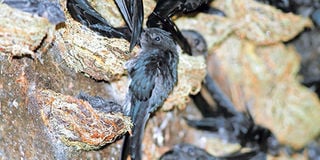Birds’ nest that will cost you a fortune

Swiftlets building a nest. The nest is made of solidified saliva and is used to make a delicious and expensive meal referred to as ‘bird’s nest soup’. FILE PHOTO | NMG
What you need to know:
- The nest refers to the dried glutinous secretions made from the salivary glands of the male swiftlets during their breeding season.
- The nest, reports indicate, costs from $2,500 (Sh250,000) to $10,000 (Sh1 million) per kilogramme. A single bowl of the soup goes for up to Sh10,000.
- Normally, the nest is boiled with rock sugar to make the ‘bird’s nest soup’, which is highly valued by the Chinese and Vietnamese for its health benefits.
- n addition, for trial purposes, the government, in partnership with universities’ research and extension departments, can invest to make the commodity available in the country.
The need to have all the essential nutrients required by the human body has necessitated the diversification of diets.
The diversification involves going for varieties of foods that are rich in different kinds of nutrients.
What comes to mind when I think of diversification is the edible bird’s nest, which has various health benefits to the human body.
The nest refers to the dried glutinous secretions made from the salivary glands of the male swiftlets during their breeding season.
The swiftlet (Aerodramus fuciphagus) is a small bird of the swift family found mainly in South-east Asia. Its nest is made of solidified saliva and is used to make a delicious and expensive meal referred to as ‘bird’s nest soup’.
The nest, reports indicate, costs from $2,500 (Sh250,000) to $10,000 (Sh1 million) per kilogramme. A single bowl of the soup goes for up to Sh10,000.
Upon exposure, the saliva hardens after the bird has shaped it into a cuplike nest. It then glues itself to the ceiling of the cave or building in which the birds live.
Normally, the nest is boiled with rock sugar to make the ‘bird’s nest soup’, which is highly valued by the Chinese and Vietnamese for its health benefits.
NUTRITIONAL AND FUNCTIONAL PROPERTIES
More than half of the edible bird’s nest (62-63 per cent) consists of proteins. The other components are lipid (0.14-1.28 per cent), ash (2.1 per cent) and carbohydrates (25.62-27.76).
The major nutrient components are the glycoproteins, rich in amino acids, carbohydrates, calcium, sodium, potassium and a major component called sialic acid, which most of the functionality and stability of the nest is based on.
The nest can also be used in wound healing processes, human skin proliferation, improvement of the learning abilities and hair growth enhancement in baldheaded people, according to experiments done on some Japanese male and female subjects as well as rats. Other benefits include prevention of influenza, anti-inflammatory effects and strengthening of tight junctions.
Nest processing
In industries, the nests are cleaned by soaking in water until they soften and the tightly bound strands are partially loosened.
Manual removal of small feathers and fine plumage is then done by use of tweezers. The cleaned strands are thereafter rearranged and moulded into chips of various shapes. They are then air-dried and packaged for sale around the world.
Way forward
Inasmuch as it can form part of the food diversification programme, the nest can be an innovative product in the developing countries.
In addition, for trial purposes, the government, in partnership with universities’ research and extension departments, can invest to make the commodity available in the country.
This can be done by importing swiflets and nesting houses and hosting them in areas adjoining the ocean, which is a good place for them to adapt to the environment and easily be monitored as they continue to reproduce and produce edible nests.
The writer is based at the Department of Dairy and Food Science and Technology, Egerton University.




